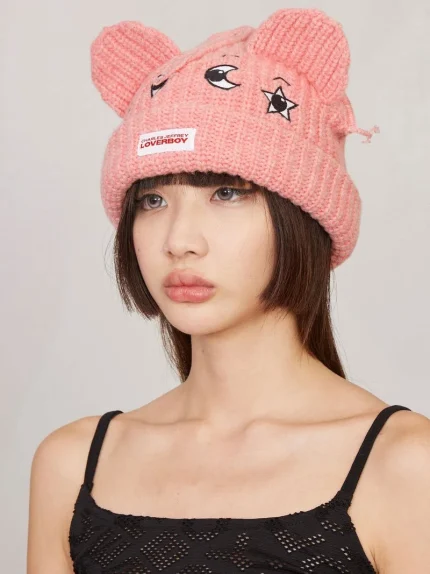Introduction: The Bold Identity of the Loverboy Hat
In a world where fashion often clings to conformity and safe aesthetics, the Loverboy hat makes a powerful case for unapologetic expression. Born from the visionary mind of Charles Jeffrey and part of the much-celebrated Loverboy fashion label, the Loverboy hat isn’t just a piece of headwear—it’s an icon, a symbol of rebellion, artistry, queerness, and fearless individuality. More than an accessory, it becomes a beacon of creative liberation, sitting atop the heads of those who dare to be different.
Charles Jeffrey Loverboy has built an empire that defies the rigid expectations of the fashion world, and the hat—whether in its horned beanie form or other experimental variations—embodies the label’s punk-meets-fantasy DNA. With its roots in club culture, political defiance, and queer celebration, the Loverboy hat has earned its place as a must-have for the avant-garde dresser. It is the crown of the outsider, worn by those who lead movements rather than follow trends.
Origin and Evolution: From Glasgow Clubs to Global Catwalks
The Loverboy hat didn’t emerge from traditional runways or legacy fashion houses. It was birthed in the underground scene of Glasgow and later flourished in the vibrant nightlife of London. Charles Jeffrey, the Scottish-born designer behind the label, originally launched Loverboy as a club night—a safe, expressive space for queer youth and creative outsiders. These parties were experimental, artistic, wild—and so was the fashion that grew from them.
The hat first gained attention when Jeffrey introduced the infamous horned beanie—often in bold colors like red, purple, or black. The design features two protruding points reminiscent of devil horns, which symbolize defiance, energy, and chaos in the most fashionable way possible. These weren’t gimmicks; they were deliberate acts of self-expression. As celebrities and influencers began donning the horned headwear, the Loverboy hat morphed from niche statement piece into a cult classic.
Design Language: More Than Just a Hat
What makes the Loverboy hat so compelling is its fearless design. Whether it’s the signature devil-horn beanie, the oversized knit balaclava, or experimental headpieces shown during London Fashion Week, each version communicates an attitude—loud, unfiltered, and art-driven. The hat is often handmade or produced in small batches, using high-quality yarns and sustainable practices, reflecting the brand’s commitment to thoughtful fashion.
The design isn’t meant to flatter the face in the conventional sense. It distorts, exaggerates, and subverts—pulling inspiration from punk aesthetics, surrealism, and the queer body as performance art. This makes the Loverboy hat less about fashion trends and more about personal mythology. It’s the type of piece that transforms not only an outfit but also the persona of the wearer.
A Queer Symbol: Identity and Politics Woven into Fashion
There is a distinctly political dimension to the Loverboy hat. In the broader context of queer fashion, visibility has always been a form of resistance. The Loverboy hat is loud, bizarre, joyful, and confrontational—characteristics that mirror the queer experience in a society that often demands silence or assimilation.
Charles Jeffrey identifies as queer and has made it his mission to challenge gender norms and heteronormative beauty standards through his collections. The Loverboy hat, with its devil horns or oversized knit shapes, subverts traditional ideas of masculinity and femininity. It’s not about fitting in—it’s about standing out. Wearing the hat becomes an act of pride, a wearable middle finger to the systems that demand you shrink yourself to fit their mold.
The Celebrity Effect: From Runways to Streetwear Icons
As with many underground fashion staples, it didn’t take long for the Loverboy hat to capture the attention of pop culture’s most influential figures. Stars like Rihanna, Harry Styles, and Ezra Miller have all been spotted in Loverboy pieces, further fueling the brand’s ascent. The hat, in particular, became a viral fashion moment when worn during key fashion weeks, music videos, and even magazine covers.
Despite its high-fashion roots, the Loverboy hat has a raw, DIY spirit that appeals to a generation obsessed with authenticity. Its viral popularity on platforms like TikTok and Instagram shows how youth culture continues to embrace fashion that challenges the status quo. Even in mainstream visibility, the Loverboy hat hasn’t lost its edge—it remains a conversation starter, a visual shout of identity.
Styling the Loverboy Hat: How to Wear the Revolution
The Loverboy hat isn’t for the faint of heart—but it also isn’t reserved for high-fashion elitists. Part of its genius lies in its adaptability. Pair it with an oversized trench coat and combat boots for a street-goth vibe. Or wear it with a delicate mesh shirt and platform shoes to lean into glam androgyny. Because it makes such a strong statement, the rest of your look can be as minimal or as maximal as you like.
Its eccentric silhouette works as a counterpoint to both hyper-modern and vintage aesthetics. Some pair it with distressed denim and leather jackets, while others use it to top off pastel knits and oversized skirts. There are no rules—just expression. That’s the magic of the Loverboy hat: it bends to your will, never the other way around.
The Collector’s Appeal: Scarcity Meets Icon Status
Much like other cult fashion pieces—think Raf Simons’ bomber jackets or the Vetements DHL tee—the Loverboy hat has become a collector’s dream. Part of this is due to its limited runs and handcrafted quality, which means pieces can sell out quickly and appreciate in value over time. Each hat becomes not just fashion, but wearable art—an artifact of a cultural moment.
Collectors and fans of the brand often keep multiple variations, not just for style but for their symbolic significance. A red horned beanie might signify boldness, while a softer pastel knit version may represent vulnerability within rebellion. The value is not only aesthetic, but emotional—something deeply personal yet universally understood among the Loverboy community.
Beyond the Hat: Loverboy’s Expanding Universe
While the hat is arguably the brand’s most iconic piece, it’s merely the tip of the Loverboy iceberg. The label now includes full collections ranging from gender-fluid tailoring to deconstructed knitwear and dystopian accessories. Still, the hat remains the crown jewel—the instantly recognizable emblem of everything Charles Jeffrey stands for: passion, performance, protest, and play.
In many ways, the Loverboy hat serves as the gateway to an entire ideology. It invites you in with its playful design, and once inside, you’re greeted by a world of fearless fashion where nothing is off-limits. It is fashion as resistance. Fashion as art. Fashion as liberation.
Conclusion: More Than Fabric—A Movement
The Loverboy hat is not just a seasonal trend or an edgy accessory—it’s a cultural symbol. It represents an evolution in fashion where queerness, rebellion, and artistic freedom take center stage. It’s a testament to how something as simple as a hat can ignite dialogue, reshape silhouettes, and create a global movement.
In wearing a Loverboy hat, you’re not just staying warm or topping off your outfit. You’re taking part in a narrative—one that refuses to conform, that embraces the strange and the beautiful, and that dares to imagine a world where we are all free to be exactly who we are.

